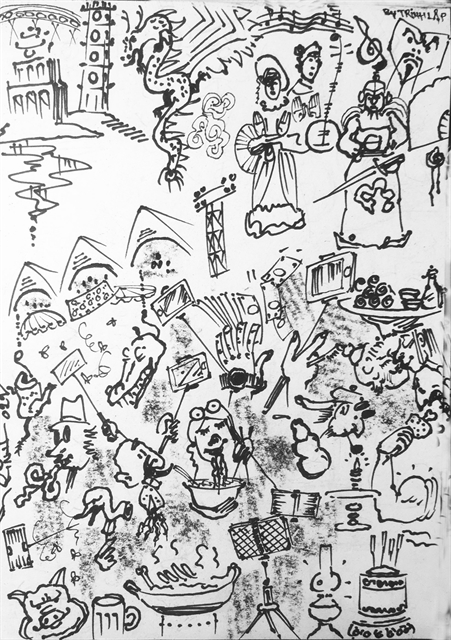 Talk Around Town
Talk Around Town

By Paul Kennedy
They came, they saw, they vlogged. They are the pests of the tourist industry; the self-obsessed ‘influencers’ whose hands are more preoccupied with their precious mobile device than their wallets.
As Việt Nam fully opens its doors to overseas visitors in our continued recovery from COVID-19, another pandemic is upon us -- our bars and cafes infected by a new breed of Tây ba lô.
With them comes a new variant of man-bunned backpackers. Where once visitors were lured here by the insatiable desire to soak up Vietnamese culture, history and the rich tapestry of everyday life, for some it seems little more than a box-ticking exercise to ‘do Asia’ as part of a parentally funded gap year (pronounced gap yaaar).
 |
| Illustration by Trịnh Lập |
The new Tây ba lô may still sport the obligatory tie-dye tees and probably own spandex psychedelic pants, but after two years of pandemic lockdown, the 2022 travellers' sole obsession seems to be to narcissistically stare at their own image, recording their experience rather than absorbing the sights and sounds of the here and now.
Even if you are unfamiliar with the term ‘vlogging’ or social media influencing, you will instantly recognise those who make it their passion.
There is a generation of fame-hungry wannabe travel correspondents who, despite having never set foot inside a journalism college, believe they are Anthony Bourdain on a global culinary tour, or think deep-dive investigations into the average price of fake Nike T-shirt makes them the next Woodward and Bernstein. Or should that be Woodbine and BeerStain?
Armed with the latest GoPro camera and selfie stick (fact: the size of the selfie stick increases in proportion to that of its user’s gargantuan ego), no passer-by is safe when the next-gen backpacker is on a recording spree. As we try to wind down with a quiet drink with friends after a busy working day, we increasingly find ourselves having to navigate past these desperate attention-seekers, the vloggers attempting to get their heads into the mobile camera frame as if they are Francis Ford Coppola directing Marlon Brando.
Their real agenda is clear, of course. What they crave is sufficient ‘likes’ and ‘clicks’ to build a fan following large enough to convince shareholders within the tourist industry to promise a lifetime of free travel, free accommodation and free food.
Now don’t misinterpret my disdain. There’s absolutely nothing wrong with promoting this amazing country to a wider audience, and we all love our holiday snaps and videos triggering spectacular memories. But there is a critical difference between capturing the moment for our own enjoyment and posterity -- a chance to relive happy times -- and the more insidious trend of implying a personal experience is a fair reflection of what it will be like in a country, or particular venue, for all future visitors. Experienced travel writers -- trained journalists -- understand there is a sense of responsibility to be balanced, fair and, most important of all, accurate with their dispatches. Sadly, these standards are neglected and ignored by the worst vloggers.
Take that famous vlogger ‘Uptin’. Since Việt Nam reopened in April, his most recent clip on our country has attracted an astonishing audience in excess of 1.8 million. The content is generally slick and entertaining, but severely let down by a grasp of basic mathematics so dire one can only presume he is suffering from dyscalculia.
Uptin’s currency conversion is inaccurate and damaging.
In one particular segment, he claims VNĐ2,000 is worth $0.08. That is correct, but then in the very next breath, he calculates that VNĐ20,000 is equivalent to $0.20. Er, no, basic maths mate, $0.08 times ten equals $0.80.
The American then goes on to say that a bowl of phở, or a bánh mì, will set you back around $1-$1.50, which is correct, but he then makes the outrageously inaccurate claim that the average minimum wage for Vietnamese is $2 a month.
Really? Come on, Uptin. With so many viewers you have a responsibility to be so much better than this. By such mathematics, Vietnamese can only afford to eat two sandwiches each, per month!
And therein lies the problem. A real, experienced journalist -- subject to the most basic editorial standards and control -- would not present such nonsense as fact.
Sadly, for content creators obsessively chasing online traffic, the truth appears to be an optional extra.
In the past few weeks, I’ve experienced first-hand the embarrassing, unpleasant behaviour of many western backpackers.
Although my Vietnamese is pretty poor, in my local bia hơi, I’m often the go-to westerner the staff call upon to help a tourist navigate the menu. Last week, two Tây ba lô, male and female, were ushered my way. I asked what type of food they would like, to which their response was the “cheapest thing on the menu”.
“Clearly they are working to a tight budget,” I thought.
Then, to my disgust, vlog filming began as they tucked into the ONE plate of noodles they had purchased to share, while consuming their own drinks they had brought to the venue. The locals in the bia hơi unwittingly found themselves cast as extras in this cheap couple’s low-budget production.
There was a similar episode the following day. This time two men (one with man-bun, one with beard) splashed out a little bit more and added a few bia hơis to their two plates of mì xào bò. Again, armed with GoPro, they set about creating content of their amazing experience eating a plate of beef noodles. What thrilling viewing. Suffice it to say, Coppola and Martin Scorsese can sleep easy in their beds tonight.
When they came to pay, the bill came to VNĐ14,000 shy of VNĐ200,000. Did they tip? Did they say keep the change? No, of course not. They waited for the server to count out VNĐ14,000 and went on their merry way.
If you’re not sure how much VNĐ14,000 equates to in western currency, don’t ask Uptin.
Tipping is hardly compulsory, but here is a free one from me to any vlogger reading this: if you are using a restaurant as a set location while filming staff and customers without permission, some old-fashioned courtesy, good manners and, yes, the occasional leaving behind of change would not go amiss. That VNĐ14,000 means a hell of a lot more to the server than it does to you.
I have saved the worst until last. The biggest western backpacker shame was served up courtesy of a young American man and his two Scandinavian female friends.
When I offered help with their ordering they explained they would like chicken, pork and a beef dish, served with rice. So far, so reasonable.
I’d left before they had finished only to receive a frantic video call from a friend who works at the bia hơi who duly put the trio on the phone. Screaming and shouting, they claimed they were being ripped off, and more to the point, I was in on the scam.
Their bill came to less than VNĐ250,000 between them, a little over $3 each. Good value for a slap-up meal with drinks on top, you would imagine. Now they were claiming they had no money. One can only presume they thought they were doing the bia hơi a favour by blessing it with their presence and, presumably, social media reach, dining out in a make-believe world in which actually paying for food and service is discretionary.
It’s doubtful these observations will have any effect on the future behaviour of visiting Tây ba lô. Many are lured here because they believe Việt Nam ‘is so cheap’ and therefore ripe for exploitation.
We welcome tourists. We want tourists. We need tourists. But more than ever post-COVID 19, we also want them to play and pay fair, understanding the needs of, and investing in, our local economy rather than using our bia hơi as a means of fattening those wallets they seem so reluctant to open when here. VNS


.jpg)

